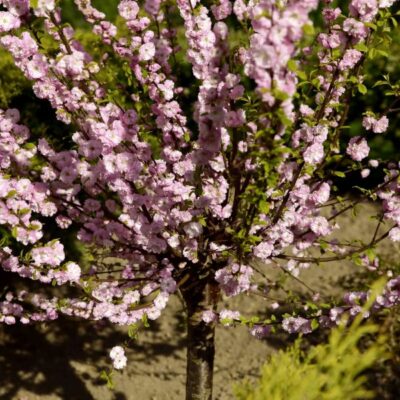Garden Plant: Double Flowering Plum Tree
Product Description: Double Flowering Plum Tree

Amazing Spring Blooms Double Flowering Plum Tree
- Gorgeous Double Pink Flowers in Early Spring
- Grass Green Foliage Turns Orange in Fall
- Naturally Rounded Form
- Butterfly and Songbird Magnet
- Hardy Tree Thrives in Cold Climates
- Thrives in a Wide Range of Soils
- Can be Trained as a Standard or Multi-Trunk Small Tree
If you want to add a standout flowering accent tree to your landscape this year, You’ll want to take a nice, slow look at this gorgeous offering. Double Flowering Plum (Prunus triloba) has the most incredible double, candy-pink flowers that seem to blanket each branch with fat pom-poms of color in early spring.
The amazing sight is even more welcome, as it’s one of the first plants to bloom in spring. What a sight for sore eyes, long tired of the bland, boring, barren winter season. You’ll adore the amazing blooms every year.
Perk up your Spring Garden with one, or several of these small trees used in a grove. From a distance, a stand of these trees in your yard will look like a fluffy, pink cotton cloud.
Double Flowering Plum puts on quite a show for you each year. You can count on the reliable performance. Few spring-blooming trees get the reaction that the Prunus triloba does!
Even without the spectacular flowers, the Double Flowering Plum is robust, beautiful and stately tree with a round shape. Ethereal spring and summer foliage is more of a light grass green than a heavy dark green. The leaves transforms to an attractive yellow-bronze-orange color in the fall.
The Double Flowering Plum is also known by a number of different names including the Rose Tree of China, Dwarf Flowering Cherry, and most commonly the Flowering Almond. The plant is a native of China and is a great representation of the exquisite loveliness of many Oriental plants.
We sell out of this special plant almost as soon as the crop is ready for sale. Snap one or more up for yourself, order today!
How to Use Double Flowering Plum Tree in the Landscape
This is a fantastic specimen tree for your front yard where it can be enjoyed by your family and neighbors alike. Get ready to see cars slow down and savor the sight in spring.
However, the Double Flowering Plum is actually a very versatile plant that can be used as trees or shrubs in many landscape applications. The tree form can be grown as either as a single or multi trunk tree. Or, you can keep the lowest branches on and use it as an ornamental large shrub.
Trained to a single trunk standard, this lovely tree develops a broad canopy. Plant it near patios as a wonderful accent tree. Why not use several of them in a small group as a pretty focal point?
A fast grower, the Double Flowering Plum makes a great screening plant. Plant a row of them 5 feet on center as a deciduous hedge or to identify borders and property lines. Measure from the center of one to the center of the next.
Songbirds love this tree too! Plant one near your edible garden. The birds will deliver a valuable service for you. Use those hungry birds to gain effective control over insect pests without sprays or nasty chemicals.
Pro Plant Tips for Care
Double Flowering Plum benefits from a slightly acidic soil that is rich in organic matter. Add a top dressing of compost and apply soil Sulphur once a year to maintain a lower pH in higher pH soils or in area with high pH water.
Choose a location with good draining soil. If poor drainage is suspected, You’ll want to “mound up” by planting in a raised bed. Or, add 18 inches of soil and plant in that mound.
Air circulation is also important for the Double Flowering Plum tree. Although hardy to a wide range of climates, if planted in poorly ventilated areas, the Prunus triloba can bloom early in colder climates resulting in blossom damage. Give it space to receive proper air flow all around the tree.
Though tolerant of part shade, the bloom is much greater in full sun. Use a thick layer of mulch over the top of the root system after planting. Be sure to pull the mulch back away from the trunk by several inches.
Mulch in the summer to help keep roots cool and surface moisture levels consistent. This also help to decrease water needs.
This is an easy plant to keep trimmed. Prune out any dead wood or crossing limbs in the spring after blooming if finished. Cut long, arching lateral branches back just above a leaf bud to keep it to the desired height.
Treat yourself with this wonderful springtime “eye candy. ” Order this special tree for your landscape today!


